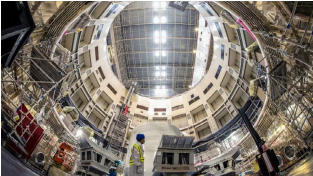FST JOURNAL
The UK Nuclear Fusion Programme
The debate
The urgent and essential nature of needing a low carbon, sustainable energy solution is so great that it is worth trying different and diverse approaches to fusion. Nobody knows which will be first or commercially viable, longer term. It could well be that the first fusion power plant that turns on a light in a home will not be representative of the thing that ends up with dominant market position.
The UK has been operating JET which is a conventional tokomak, but we have also invested in spherical tokomaks and remain the world leaders in tokomaks. Conversely Germany is the world leader in accelerators and the US is a leader in inertial confinement. Different states have a thing that they dominate with, and valuing that diversity is a smart thing to do. We can’t do them all in one country, so it is a global endeavor. However, the underpinning technology of all of those approaches is largely common. So the UK strategy of having a power plant design programme is enabling the growth and development of suppliers in those key technologies which can be supplied to any varied of power plant. You enable an industry which can support any variant of approach to nuclear fusion.
One of the other things that the UK has a world lead in is the underpinning technology of high energy and high repetition rate lazers. We need to be incredibly careful to act now and commericialise this technology so that we maintain our world lead. STEP is a logical next step for the UK given our knowledge and heritage on the area. If we can build a thriving sector with a wide breadth then we have the ability to bring forward new technologies.
EuroAtom and ITER have been central in developing technology, skills and standards for the fusion sector and the UK’s departure from the EuroAtom understandably brings concern for some. Europe is going through many changes and it’s important to understand what Europe wants to do with fusion and there is a feeling that it needs to evolve with organisation and timelines. The UK Government says that separating from Europe has enabled it to build some of the programmes that it is currently working on, but that it is still open to international cooperation. The UK has also remained within the European grant giving process and the ITER programme, which enables it to stay connected and linked in with Europe. However, the exit from EuroAtom has made it challenging for academia to participate in ITER because the relationship is with the UK AEA rather than universities.

A participant from the audience commented that experts should be more transparent with the public on the amount of energy and resourced needed to produce high gain in nuclear fusion. Pannelists commented that getting to a sustainable, visible and commercial point where fusion becomes energy for homes is still a challenge. But like when gas over took coal, everything in energy moves slowly. The physics works and now that the National Ignition Facility (NIF) has demonstrated ignition, this should open doors.
There is lots of spill over for investment in fusion. Many of the technologies developed within the nuclear fusion space can be used across the wider applications such as with tritium storage and hydrogen and robotic innovation.
Further information
https://www.gov.uk/government/organisations/uk-atomic-energy-authority
https://www.iter.org/
https://ccfe.ukaea.uk/programmes/joint-european-torus/
https://en.wikipedia.org/wiki/Euratom
